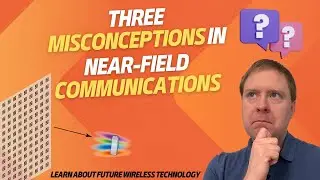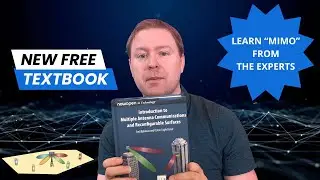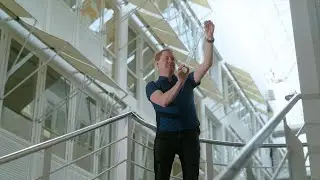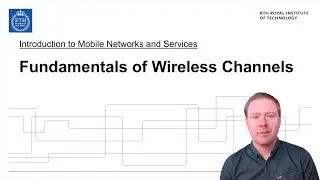Introduction to Multiple Antenna Communications and Reconfigurable Surfaces
Professor Emil Björnson explains why he wrote the open-science book "Introduction to Multiple Antenna Communications and Reconfigurable Surfaces" together with Özlem Tuğfe Demir. In particular, he answers the questions: What is covered by the book? Who is the book written for? Where can I get the book?
You can download the PDF for free from: https://www.nowpublishers.com/article...
The simulation code is available at https://github.com/emilbjornson/mimobook
Book description:
Wireless communication is the backbone of the digitized society, where everything is connected and intelligent. Access points and devices are nowadays equipped with multiple antennas to achieve higher data rates, better reliability, and support more users than in the past. This book gives a gentle introduction to multiple antenna communications with a focus on system modeling, channel capacity theory, algorithms, and practical implications. The basics of wireless localization, radar sensing, and controllable reflection through reconfigurable surfaces are also covered. The goal is to provide the reader with a solid understanding of this transformative technology that changes how wireless networks are designed and operated, today and in the future.
The first three chapters cover the fundamentals of wireless channels, and the main benefits of using multiple antennas are identified: beamforming, diversity, and spatial multiplexing. The theory and signal processing algorithms for multiple-input multiple-output (MIMO) communications with antenna arrays at the transmitter and receiver are progressively developed. The next two chapters utilize these results to study point-to-point MIMO channels under line-of-sight (LOS) and non-LOS conditions, covering the shape of signal beams, impact of array geometry, polarization, and ways to achieve reliable communication over fading channels. The book then shifts focus to multi-user MIMO channels, where interference between devices is managed by spatial processing. The next chapter extends the theory to multicarrier channels and explains practical digital, analog, and hybrid hardware implementations. The last two chapters cover the role of multiple antennas in localization and sensing, and how reconfigurable surfaces can improve both communication and sensing systems.
The text was developed as the textbook for a university course and builds on the reader's previous knowledge of signals and systems, linear algebra, probability theory, and digital communications. Each chapter contains numerous examples, exercises, and simulation results that can be reproduced using accompanying code. The accompanying code and material is available at https://github.com/emilbjornson/mimobook












![Bit Error Ratio or Channel Capacity: Which metric should I use? [Frequently Asked Questions]](https://images.videosashka.com/watch/sK537pnqjWM)
![Ep 40. Synchronization of Massive Antenna Arrays [Wireless Future Podcast]](https://images.videosashka.com/watch/dS4E5Jy7DQk)

![Ep 39. Radio Stripes at Terahertz (With Parisa Aghdam) [Wireless Future Podcast]](https://images.videosashka.com/watch/BvWAtb9gpAU)
![How many beams can you send from a MIMO array? [Frequently Asked Questions]](https://images.videosashka.com/watch/tXDN4BFSSnI)
![Ep 38. Things We Learned at the 6G Symposium [Wireless Future Podcast]](https://images.videosashka.com/watch/j0HOLZjGRUQ)
![Ep 37. Wireless Future Panel Discussion (Live Podcast) [Wireless Future Podcast]](https://images.videosashka.com/watch/PX23UWSFzSU)

![6G kräver många fler antenner än idag - så ska det gå till! [English version exists]](https://images.videosashka.com/watch/HJMYruMz46Y)


![Ep 36. 6G from an Operator Perspective [Wireless Future Podcast]](https://images.videosashka.com/watch/odqBsaSBo-4)
![Beamwidth, beam pattern, and sensing [Part 5, Fundamentals of mmWave communication]](https://images.videosashka.com/watch/UbA4IbFXTSU)
![Maximum ratio and zero-forcing beamforming [Part 4, Fundamentals of mmWave communication]](https://images.videosashka.com/watch/w46c0QhByPg)
![Constructive and destructive interference [Part 3, Fundamentals of mmWave communication]](https://images.videosashka.com/watch/hxkojUEKAR0)
![Wireless propagation losses [Part 2, Fundamentals of mmWave communication]](https://images.videosashka.com/watch/H7Vh-7kiejQ)
![Beamforming directivity [Part 1, Fundamentals of mmWave communication]](https://images.videosashka.com/watch/WOE_nKBKUsE)
![Ep 35. Ten Challenges on the Road to 6G [Wireless Future Podcast]](https://images.videosashka.com/watch/t4W4OEPtsuQ)

![Ep 34. How to Achieve 1 Terabit/s over Wireless? [Wireless Future Podcast]](https://images.videosashka.com/watch/Zb0nHvR_TB4)